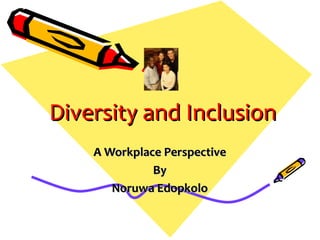
Here are some potential action goals for dealing with discriminatory behavior at work:1. Educate myself on different types of biases and discrimination so I can recognize them better. 2. Speak up respectfully if I witness biased or exclusionary behaviors and language.3. Make a conscious effort to get to know colleagues from different backgrounds than my own.4. Advocate for diversity and inclusion initiatives in my workplace. 5. Participate in diversity training opportunities to strengthen my cultural competence
- 1. Diversity and Inclusion A Workplace Perspective By Noruwa Edopkolo
- 2. Program Objectives • Emphasize the value of diversity. • Eliminate misconceptions of diversity and its effects. • Improve the management of diversity. • Develop greater workplace productivity. • Enhance human relations.
- 3. Focus Areas • What is diversity? • Why is it important to understand diversity? • What are the consequences of not managing diversity • How to manage diversity?
- 4. Definition of terms What is diversity? • The fact or quality of being diverse; difference. • A point or respect in which things differ. • The ways we are different; the condition of having unique characteristics. The condition of being diverse : Variety ; especially : the inclusion of diverse people (as people of different races or cultures) in a group or organization. What is Inclusion? • The act of including or the state of being included. • Something included.
- 5. Aspects of diversity • Age ( generational differences) • Race • Gender Ethnicity • Sexual orientation • Religion. • Physical attributes etc. • Education • Job Title ,function ,skills. • Disability • Height/Weight • Marital status. • Language/Accent.
- 6. Why is it important to understand diversity? Diversity is more than just tolerating differences. It is: • respecting, appreciating, and understanding the varying characteristics of individuals. • Everyone is unique and no single person is a representative of a certain group. Stereotypes and other racial biases/prejudices are damaging to a business.
- 7. Cont.. What about “ generation?” Definition: A body of individuals born in approximately the same time period who generally share similar behaviors and attitudes. Understand that there are now four (4) generations in the workplace with different: • expectations, • motivations, • attitudes, and • behaviors. An understanding of these generational differences can equip one to handle workplace situations with increased insight.
- 8. The Four (4) Generations • Traditionalists/Veterans (Born 1922-1945) • Baby Boomers (Born 1946-1964) • Generation X (Born 1965-1982) • Millennia's/Generation Y (Born 1983-1997)
- 9. What are the generations in your organization? How they differ: • Preferred Leadership Approach. • Communication Style. Motivational Buttons. • How They Interact with Others. • Preferred Approach to Feedback. • View toward the Company. • Work Vs. Personal Life. • Desired Rewards. • Financial Behaviors. • Relationship with Technology. • Expectations.
- 10. Benefits of Understanding Generational differences: • More effective communication • less misunderstandings. • Increased recruitment and employee retention. • More effective motivational methods. • Better-formed expectations. • Increased productivity and teamwork.
- 11. Consequences of not managing diversity. • Discrimination • breeds narrow-mindedness, • impairs employee morale, • strains employee relationships, • and thus, damages productivity. Not to mention, it is illegal and costly in terms of litigation!
- 12. Group discussion What words describe the attitude to diversity in your organization? Time : 10mins.
- 13. managing diversity – The organization is diverse by default, and now it must deal with it. – Effectively managing diversity can improve organizational effectiveness – When managers commit to diversity , it legitimizes diversity effort of others. – Promoting a nondiscriminatory workplace environment – Research suggests slight differences in treatment can cumulate and result in major disparities over time
- 14. Top-management commitment and rewards for the support Of diversity are critical ingredients for the success of diversity management initiatives. Managing Diversity Effectively Makes Good Business Sense What a Diversity of Employees Provides – A variety of points of view and approaches to problems and opportunities can improve managerial decision making. – Diverse employees can provide a wider range of creative ideas. – Diverse employees are more attuned to the needs of diverse customers. – Diversity can increase the retention of valued organizational members. – Diversity is expected/required by other firms
- 15. Diversity Bias • Assumptions of Superiority – I’m better than you. • Assumptions of Correctness – This is the way it should be • Assumptions of Universality – We’re all the same. Everybody is just like me.
- 16. The Challenge of Workplace Diversity? • The challenge lies in the continuous improvement of the integration and social acceptance of people from different backgrounds. • Our differing human characteristics influence the way we think, act, interact, and make choices. • Often, these differences interfere with our ability to support, trust, and respect each other, and thus to effectively function together.
- 17. Avoiding bias • Similar-to-me effect – perceive others who are similar to ourselves more positively than we perceive people who are different • Social status effect – perceive individuals with high social status more positively than those with low social status. • Salience effect – focus attention on individuals who are conspicuously different. • Knowingly and willingly denying divers individuals access to opportunities and outcomes in an organization
- 18. summary Steps in Managing Diversity Effectively – Empower employees to challenge discriminatory behaviors, actions, and remarks – Reward employees for effectively managing diversity – Provide training utilizing a multi-pronged, ongoing approach – Encourage mentoring of diverse employees.
- 19. Action Goals • List 5 personal commitment action goal for dealing with discriminatory behavior at work? • Determine your generational differences with your colleagues, have you been sensitive to the diversity difference.